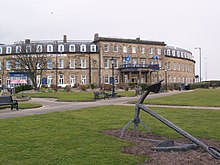Fleetwood
Fleetwood acquired its modern character in the 1830s, when the principal landowner Peter Hesketh-Fleetwood, High Sheriff and MP, conceived an ambitious plan to re-develop the town to make it a busy seaport and railway spur.
There is also evidence of a Roman road running from Ribchester to Kirkham (12 miles (19 km) southeast of Fleetwood) which then makes a sharp turn to the northwest.
No direct evidence of the port has been found, but in 2007, an Iron Age settlement was discovered at Bourne Hill, just south of present-day Fleetwood, suggesting the area was populated in pre-Roman times.
It was ultimately sold to Thomas Fleetwood, comptroller of the Royal Mint, whose son Edmund, expanded the house into Rossall Hall.
After some delays, he recruited the prominent architect Decimus Burton, whose work in St Leonard's-on-Sea he had admired, to lay out what would be the first planned town of the Victorian era.
The crown jewel was the North Euston Hotel, built in 1841, a fine semi-circular building overlooking the bay and the river's estuary.
The hotel was built to serve overnight guests making the railway journey from Euston, and was close to the point of departure for the steamers to Scotland.
This journey was made by Queen Victoria in 1847, but by the mid-1850s the completion of the western railway link between London and Scotland over Shap Fell rendered Fleetwood's role as a transport terminus obsolete.
However, by the late 1850s, the combination of the new western railway route and the rise of neighbouring Blackpool as a prominent seaside resort signalled a decline in the town's fortunes.
A second Act in 1871 gave construction authority to the Lancashire and Yorkshire Railway Company, under chief engineers Sir John Hawkshaw and Harrison Hayter.
However, at the same time this was more than offset by a period of rapid expansion of the fishing industry, signalled by the launch in 1891 of the first steam powered trawler, the Lark.
James Marr brought a fleet of steam trawlers to Fleetwood and actively started to change the port by selectively fishing for hake, which until then had been treated as a much less desirable catch.
Over the next few years, the sea front along the north shore was developed in resort fashion, to encourage visitors for whom the brashness of Blackpool was too daunting.
This development led indirectly to some renewal of the then largely derelict Dock Street area, and improved road access to the town to support the container traffic.
The derelict dock landing area was developed into Freeport, a retail centre, and housing has been built at the north end of the marina.
Fleetwood is in the northwest corner of the Fylde coastal plain, 8 miles (13 km) north of Blackpool, on the western side of the mouth of the River Wyre.
The town is on a peninsula, almost 2 miles (3 km) wide, bounded to the west by the Irish Sea, to the north by Morecambe Bay and to the east by the River Wyre estuary.
Like the remainder of the Fylde, the land is extremely flat, the highest point being the Mount, the large sand dune in the northern part of the town, from which the original street plan radiated.
Prevailing winds and weather patterns are northwesterly, leading to a slightly higher average precipitation than the country as a whole, although the absence of high ground in the immediate vicinity moderates this.
[13] Fleetwood's economy still revolves around the traditional areas of fishing, tourism, port activity and light industry, but since the early 1970s the town has continued to struggle economically.
Using figures indicating benefit claimants as a percentage of total population (usually considered to be about half the 'actual' unemployment rate)[15] the figures for August 2007 are:[16] Average household income in August 2007 was as follows:[17] The town's largest and most prominent single employer is Lofthouse's of Fleetwood Ltd., manufacturers of Fisherman's Friend—a menthol lozenge popular worldwide and especially in Japan.
[18] The plan has three main areas for development: The town's most prominent feature is the Mount, a 7-acre (2.8 ha) park facing the sea-front, laid out by Decimus Burton, and built on a large sand dune originally known as Tup's Hill.
[30] The museum also operates the Jacinta, the town's "heritage trawler", stationed in the Wyre Dock Marina and open for public viewing throughout the year.
[38] The opening concert was staged each year onboard Jacinta, the town's heritage trawler, however due to the vessels general poor state of repair, this is no longer the case.
[42][43] Fleetwood Beer & Cider Festival is held in February each year and is organised by the Blackpool, Fylde and Wyre branch of CAMRA.
[45][46][47][48] Operatic tenor Alfie Boe grew up in Fleetwood[49][50] and his first public performance was at the Marine Hall at the age of 14, where he worked as a stage technician.
[52] The best-known rock bands to feature musicians from Fleetwood are television talking head John Robb's the Membranes and Goldblade,[citation needed] punk band One Way System[53] (the first signing on Cherry Red's Anagram Records),[54] Uncle Fester/UFX,[55] Earthling Society, who have released six critically acclaimed albums,[56][57] and Kiss of the Gypsy,[58] who were signed to Atlantic Records in the US.
was founded in 1908 and wound up in 1976, having been several times Lancashire Combination cup champions in the 1930s, and founder members of the Northern Premier League in 1968.
In June 2021 a feasibility study was submitted by the Lancashire County Council to the Department for Transport to re-open the line from Fleetwood to Poulton-le-Fylde, under the government's Restoring Your Railway programme.
The town is also home to a large public library, which as well as lending print and audio-visual material also has an extensive reference and local studies collection.










